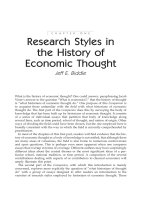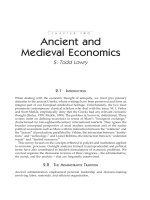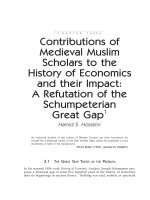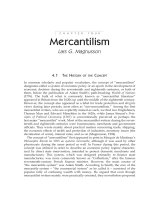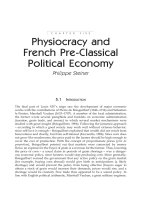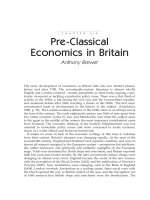ORGANIZATION BEHAVIOR research companion to the dysfunctional workplace, management challenges an
Bạn đang xem bản rút gọn của tài liệu. Xem và tải ngay bản đầy đủ của tài liệu tại đây (2.12 MB, 494 trang )
RESEARCH COMPANION TO THE
DYSFUNCTIONAL WORKPLACE
NEW HORIZONS IN MANAGEMENT
Series Editor: Cary L. Cooper, CBE, Professor of Organizational Psychology and Health,
Lancaster University Management School, Lancaster University, UK
This important series makes a significant contribution to the development of management thought. This field has expanded dramatically in recent years and the series provides
an invaluable forum for the publication of high quality work in management science,
human resource management, organizational behaviour, marketing, management information systems, operations management, business ethics, strategic management and
international management.
The main emphasis of the series is on the development and application of new original
ideas. International in its approach, it will include some of the best theoretical and empirical work from both well-established researchers and the new generation of scholars.
Titles in the series include:
Supporting Women’s Career Advancement
Challenges and Opportunities
Edited by Ronald J. Burke and Mary C. Mattis
Research Companion to Organizational Health Psychology
Edited by Alexander-Stamatios G. Antoniou and Cary L. Cooper
Innovation and Knowledge Management
The Cancer Information Services Research Consortium
J. David Johnson
Managing Emotions in Mergers and Acquisitions
Verena Kusstatscher and Cary L. Cooper
Employment of Women in Chinese Cultures
Half the Sky
Cherlyn Granrose
Competing Values Leadership
Creating Value in Organizations
Kim S. Cameron, Robert E. Quinn, Jeff DeGraff and Anjan V. Thakor
Research Companion to Working Time and Work Addiction
Edited by Ronald J. Burke
Happy-Performing Managers
Peter J. Hosie, Peter P. Sevastos and Cary L. Cooper
Women in Leadership and Management
Edited by Duncan McTavish and Karen Miller
Appreciative Inquiry and Knowledge Management
A Social Constructionist Perspective
Tojo Thatchenkery and Dilpreet Chowdhry
Research Companion to the Dysfunctional Workplace
Management Challenges and Symptoms
Edited by Janice Langan-Fox, Cary L. Cooper and Richard J. Klimoski
Research Companion to the
Dysfunctional Workplace
Management Challenges and Symptoms
Edited by
Janice Langan-Fox
Professor of Management, Swinburne University of Technology, Australia
Cary L. Cooper CBE
Professor of Organizational Psychology and Health, Lancaster University
Management School, UK
Richard J. Klimoski
Professor of Psychology and Management and Dean, School of
Management, George Mason University, USA
Edward Elgar
Cheltenham, UK • Northampton, MA, USA
© Janice Langan-Fox, Cary L. Cooper and Richard J. Klimoski 2007
All rights reserved. No part of this publication may be reproduced, stored in a retrieval system or
transmitted in any form or by any means, electronic, mechanical or photocopying, recording, or
otherwise without the prior permission of the publisher.
Published by
Edward Elgar Publishing Limited
Glensanda House
Montpellier Parade
Cheltenham
Glos GL50 1UA
UK
Edward Elgar Publishing, Inc.
William Pratt House
9 Dewey Court
Northampton
Massachusetts 01060
USA
A catalogue record for this book
is available from the British Library
Library of Congress Cataloguing in Publication Data
Research companion to the dysfunctional workplace : management challenges and symptoms /
edited by Janice Langan-Fox, Cary L. Cooper, Richard J. Klimoski
p. cm.—(New horizons in management series) (Elgar original reference)
Includes bibliographical references and index.
1. Organizational behavior. 2. Conflict management. 3. Organizational effectiveness.
4. Corporate culture. I. Langan-Fox, Janice, 1946– II. Cooper, Cary L. III. Klimoski,
Richard J.
HD58.7.R47 2007
658.3’045—dc22
2007002142
ISBN 978 1 84542 932 4
Printed and bound in Great Britain by MPG Books Ltd, Bodmin, Cornwall
Contents
Contributors
Preface
Introduction
PART I
vii
xi
xiii
BARRIERS TO PRODUCTIVE WORK
1 When good people do nothing: a failure of courage
Christopher R. Rate and Robert J. Sternberg
2 Personality disorders and derailment at work: the paradoxical
positive influence of pathology in the workplace
Adrian Furnham
3
22
3 Problems of employees with personality disorders:
the exemplar of obsessive-compulsive personality
disorder (OCPD)
40
Michael Kyrios, Maja Nedeljkovic, Richard Moulding
and Guy Doron
4 Tyrants and workplace bullying
Janice Langan-Fox and Michael Sankey
58
5 The struggle of the self: identity dysfunctions in the
contemporary workplace
Glen E. Kreiner
6 Why bad leaders stay in good places
Debra L. Shapiro and Mary Ann Von Glinow
75
90
7 Leadership and ethics: the darker side of management
Marc J. Schabracq and Iva Embley Smit
110
8 Employee loss of trust in management: surviving in a new era
Roger C. Mayer
125
9 Employee attachment and deviance in organizations
Thomas E. Becker and Rebecca J. Bennett
136
10 Work hours and work addiction: work now, pay later
Ronald J. Burke and Teal McAteer
152
11 Feedback phobia? Why employees do not want to give
or receive performance feedback
Jeanette N. Cleveland, Audrey S. Lim and Kevin R. Murphy
168
12 Everybody hurts, sometimes: the language of emotionality
and the dysfunctional organization
Anjana Anandakumar, Tyrone S. Pitsis and Stewart R. Clegg
187
v
vi
Research companion to the dysfunctional workplace
13 Humor in organizations: no laughing matter
Robert E. Wood, Nadin Beckmann and Fiona Pavlakis
PART II
216
MANAGING ORGANIZATIONAL MAYHEM
14 The role of organizational practices and routines in
facilitating normalized corruption
Mahendra Joshi, Vikas Anand and Kevin Henderson
235
15 The dysfunction of territoriality in organizations
Graham Brown and Sandra L. Robinson
252
16 Towards a relational model of workplace aggression
M. Sandy Hershcovis and Julian Barling
268
17 Understanding and deterring employee theft with
organizational justice
Edward C. Tomlinson and Jerald Greenberg
285
18 When teams fail in organizations: what creates
teamwork breakdowns?
Dana E. Sims and Eduardo Salas
302
19 Collective wisdom as an oxymoron: team-based structures
as impediments to learning
Michael D. Johnson and John R. Hollenbeck
319
20 The bright and dark sides of personality: implications for
personnel selection in individual and team contexts
Timothy A. Judge and Jeffery A. LePine
332
21 Motives and traits as a driver of adaptive and maladaptive
managerial styles
Sharon L. Grant
356
22 Avoiding entrepreneurial frustration: building
a management team
Robert D. Hisrich and Julie Lutz
380
23 Organizational change and its dysfunctional effect
on managers in large organizations
Les Worrall, Cary L. Cooper and Kim Mather
402
24 Helping creativity and innovation thrive in organizations:
functional and dysfunctional perspectives
Neil Anderson and Rosina M. Gasteiger
422
25 ‘Dysfunctional’ subcultures in organizations: threat
or a key to enhancing change?
Roy J. Lewicki, David Greenberger and Erin Coyne
441
Index
461
Contributors
Vikas Anand, Sam M. Walton College of Business, University of Arkansas, USA
Anjana Anandakumar, University of Technology, Sydney, Australia
Neil Anderson, University of Amsterdam Business School, The Netherlands
Julian Barling, School of Business, Queens University, Kingston, Ontario, Canada
Thomas E. Becker, Department of Business Admininstration, University of Delaware,
Newark, DE, USA
Nadin Beckmann, Australian Graduate School of Management, Sydney, Australia
Rebecca J. Bennett, Department of Management and Information Systems, College of
Administration and Business, Louisiana Tech University, USA
Graham Brown, Lee Kong Chian School of Business, Singapore Management
University
Ronald J. Burke, Schulich School of Business, York University, Toronto, Canada
Stewart R. Clegg, University of Technology, Sydney, Australia
Jeanette N. Cleveland, Department of Psychology, The Pennsylvania State University,
USA
Cary L. Cooper, Lancaster University Management School, UK
Erin Coyne, Fisher College of Business, Department of Management and Human
Resources, Ohio State University, USA
Guy Doron, Department of Psychology, University of Melbourne, Australia
Iva Embley Smit, Faculty of Social and Behavioural Sciences, Work and Organizational
Psychology, University of Amsterdam, The Netherlands
Adrian Furnham, Department of Psychology, University College, London, UK
Rosina M. Gasteiger, University of Amsterdam Business School, The Netherlands
Sharon L. Grant, Faculty of Business and Enterprise, Swinburne University of
Technology, Melbourne, Australia
Jerald Greenberg, Department of Management and Organization, National University of
Singapore Business School, Singapore
David Greenberger, Fisher College of Business, Department of Management and Human
Resources, Ohio State University, USA
Kevin Henderson, Sam M. Walton College of Business, University of Arkansas, USA
vii
viii
Research companion to the dysfunctional workplace
M. Sandy Hershcovis, I.H. Asper School of Business, University of Manitoba, Canada
Robert D. Hisrich, Thunderbird, The Garvin School of International Management,
Arizona, USA
John R. Hollenbeck, Department of Management, Michigan State University, USA
Timothy A. Judge, Warrington College of Business, Department of Management,
University of Florida, USA
Michael D. Johnson, Department of Management, Michigan State University, USA
Mahendra Joshi, Sam M. Walton College of Business, University of Arkansas, USA
Glen E. Kreiner, Smeal College of Business, The Pennsylvania State University, USA
Michael Kyrios, Department of Psychology, Swinburne University of Technology,
Melbourne, Australia
Janice Langan-Fox, Faculty of Business and Enterprise, Swinburne University of
Technology, Melbourne, Australia
Jeffery A. LePine, Warrington College of Business, Department of Management,
University of Florida, USA
Roy J. Lewicki, Fisher College of Business, Department of Management and Human
Resources, Ohio State University, USA
Audrey S. Lim, Department of Psychology, The Pennsylvania State University, USA
Julie Lutz, Thunderbird, The Garvin School of International Management, Arizona,
USA
Teal McAteer, DeGroote School of Business, McMaster University, Canada
Kim Mather, University of Wolverhampton Business School, Compton Campus,
Wolverhampton, UK
Roger C. Mayer, Department of Management, College of Business Administration,
University of Akron, Ohio, USA
Richard Moulding, Department of General Practice, University of Melbourne, Australia
Kevin R. Murphy, Department of Psychology, The Pennsylvania State University, USA
Maja Nedeljkovic, Department of Psychology, Swinburne University of Technology,
Melbourne, Australia
Fiona Pavlakis, Australian Graduate School of Management, Sydney, Australia
Tyrone S. Pitsis, University of Technology, Sydney, Australia
Christopher R. Rate, Department of Psychology, Yale University, Connecticut, USA
Sandra L. Robinson, Sauder School of Business, University of British Columbia,
Vancouver, Canada
Contributors
ix
Eduardo Salas, Department of Psychology and Institute for Simulation and Training,
University of Central Florida, USA
Michael Sankey, Faculty of Commerce, University of Melbourne, Australia
Marc J. Schabracq, Faculty of Social and Behavioural Sciences, Work and Organizational
Psychology, University of Amsterdam, The Netherlands
Debra L. Shapiro, Robert H. Smith School of Business, University of Maryland, MD,
USA
Dana E. Sims, Department of Psychology and Institute for Simulation and Training,
University of Central Florida, USA
Robert J. Sternberg, School of Arts and Sciences, Tufts University, Massachusetts, USA
Edward C. Tomlinson, Boler School of Business, John Carroll University, Ohio, USA
Mary Ann Von Glinow, Dept. of Management and International Business, College of
Business Administration, Florida International University, USA
Robert E. Wood, Australian Graduate School of Management, Sydney, Australia
Les Worrall, University of Wolverhampton Business School, Compton Campus,
Wolverhampton, UK
Preface
I once interviewed a man called ‘Tony’ about how he did his job. He worked in a national
communications organization and had recently taken up a position as a liaison officer
after his previous job as a truck driver. The job required him to liaise between the
shopfloor, of which he was a member, and management. His story (later indirectly corroborated by executives) told of secret meetings with management, staged performances
at union meetings (throwing chairs etc.), and other extraordinary actions and hidden
communications with either the manager or union leaders. His phone bill, which covered
long late-night conversations with troubled shopfloor workers about family or work, was
astronomical. Tony controlled and managed everything. However, he was paid only for
his shopfloor liaison officer job despite having informal responsibility for the efficient
running of his unit, the pastoral care of the workers, and the propping up of management. Tony contrived to appear on the side of the union and the shopfloor, and although
never appearing to support management (at meetings, he made the manager the butt of
jokes), secretly colluded with management in order to bring about productive organizational outcomes. Both sides knew he was a power broker, but it was never spoken about.
Tony was an altruist at heart. He saw that someone had to step in and take charge of
things and, with little education (he hadn’t even finished high school) and no management
experience, he did a terrific job. This was the way things got done in the organization – to
avoid strikes, to compensate for an inexperienced and incompetent manager in charge of
120 staff, and to help workers who lived in constant fear of losing their jobs because of it.
Furthermore, according to executives, this case was repeated across at least six other units
in this national organization.
This is just one example of organizational dysfunction and the coping that took place
to keep things going. There are surely a myriad of other cases like this that we all can bring
out, stemming from our own work experiences.
Tony taught me a lot. I also began to realize that other people must also know of organizational dysfunction, perhaps derived from a more systematic perspective. As a consequence, the idea for this book emerged.
Organizational dysfunction, then, characterizes a facet of today’s workplace that is
often hidden or ignored. While this aspect of organizational life may be evident to insiders, there are few systematic treatments of the dynamics of such dysfunction that capture
the complexity of both its insidious nature and its powerful consequences – for employees, families, customers or for the firm as a whole. Our book offers such an examination
and more. That is, in a modest way, it is also a testimony to the life of many unsung workplace heroes or heroines who, on a daily basis, must cope with such challenges as
inefficiency and incompetence; people suffering from a disorder or a disposition, or the
effects of these on people around them; people doing things they have to do and don’t
want to do; organizational systems that don’t work well, make work and must be circumvented, and who make it all appear . . . normal!
When approached, authors of international repute enthusiastically embraced the idea
of the book. Hardly anyone turned down the opportunity to write a chapter on their
xi
xii
Research companion to the dysfunctional workplace
dysfunction topic of choice. These outstanding authors come from diverse backgrounds
including clinical psychology, organizational psychology, management and business,
entrepreneurship and from consulting. We, as editors, are very grateful for their enthusiasm, generosity and wonderfully interesting and well-written chapters.
Consequently, we believe that the resulting collection of chapters brought together for
this volume will be invaluable for a wide variety of readers: researchers from different disciplines – workplace health, psychology, commerce, management. Although we already
know a great deal, as is made clear throughout the volume, there are still many issues or
applied problems that need further investigation. Similarly, consultants and professionalsin-training will be better prepared to offer high-quality service delivery if they take to heart
the many lessons already learned as presented throughout our text. And of course, those
responsible for ensuring the effectiveness of work organizations, including managers,
supervisors and HR professionals, should gain useful insights on how to improve the
design of human resource policy and practices as well as how best to create the kind of
progressive workplace culture that most of us desire.
We are grateful to Jo Betteridge of Edward Elgar, our publishers, and to Edward Elgar
himself, who loved the idea of the book because of his own experiences! Cary, Richard
and I wish to thank them for their assistance. Without it, this book would never have been
published.
Janice Langan-Fox
November 2006
Introduction
This book delves into the ‘underbelly’ of organizations. It’s about subversiveness, counterproductive behaviour, psychological disorders, and nearly every other aspect of an
organization that could become dysfunctional. To be sure, organizational dysfunction has
always existed in one form or another. Moreover, it is often at the heart of works of fiction
or tabloid exposés. However it has only recently become a focus for systematic investigation and a field of research. Thus you, the reader, should find the content of this volume
novel, exciting and, we predict, useful. Our treatment of dysfunction is extensive and
detailed. The authors of the volume discuss the features of dysfunction – what they are,
what they do to an organization, what research has been conducted and what was found.
They also describe what happens when ‘toxic issues’ become comfortably bedded down
and institutionalized. But then they go on to make recommendations for interventions
and improvements. They give us hope for the future.
The book is organized around two themes: ‘Barriers to productive work’ and
‘Managing organizational mayhem’. The first theme explores organizational dysfunction
as it concerns individuals, and the second examines broader issues of dysfunction and the
effects involving teams, managers and organization-wide systems.
Contributors responded to a broad class of variables related to the ‘dysfunctional
organization’. Rate and Sternberg (Chapter 1) address what they see as a crisis of courage
in corporate boardrooms. They state that up to two-thirds of people currently in management positions fail and that groups of people collude to overlook the negative actions
of colleagues, resulting in a failure of courage. Focusing on behaviours such as intentionality, deliberation, risk, good purpose and personal fear, the authors show that organizations can develop programmes to enhance courageous behaviour.
Adrian Furnham (Chapter 2) examines the pathology of senior managers ‘who create
and maintain a toxic culture epitomized by mistrust, dishonesty and lack of equity’.
Adrian pursues the idea that many ‘successful’ bosses may have psychopathic, narcissistic and histrionic personality disorders which, although they may sometimes help them in
business settings, will eventually result in a dysfunctional workplace for others.
Kyrios, Nedeljkovic, Moulding and Doron (Chapter 3) focus on one disorder,
obsessive-compulsive personality disorder (OCPD), which represents a common problem
affecting workplace performance. By examining the aetiology, assessment and workplace
effects of individuals with OCPD, engagement in work tasks, and their workplace relations, Kyrios et al. reveal that the negative aspects of the disorder can be controlled and
managed.
Workplace bullying is one aspect of organizations that is difficult to control and manage.
Langan-Fox and Sankey (Chapter 4) explain how the problem emerges, develops and eventually ‘grips’ the life of the victim. The chapter reviews the literature to date, reporting both
empirical and theoretical work, and details crucial elements of the organization that facilitate bullying, as well as strategies that can be taken to prevent recurrence.
Glen Kreiner (Chapter 5) depicts how the ‘struggle for self’ emerges in dysfunctional
ways in the workplace by examining eight dysfunctions that stem from imbalanced
xiii
xiv
Research companion to the dysfunctional workplace
identity boundaries and suboptimal identification states, and concludes by suggesting
ways that can reduce the impact of these dysfunctions.
Shapiro and Von Glinow (Chapter 6) ask the question – what happens when leaders are
in fact the disruptive force in their organization? In developing a new theoretical framework that helps illuminate ‘bad leadership’, they convey the dynamics associated with
employees’ hierarchical status and how stature is associated with sources of power that
enable senior employees to remain in post long past it is appropriate to remove them.
Schabracq and Smit (Chapter 7) ask what good leadership is, and how it relates to ethics
and integrity. The authors scrutinize the influence of values in acting as a guideline and
control for behaviour at work.
Loss of employee trust in management (Chapter 8) has many negative outcomes for a
business. Roger Mayer discusses how multiple workplace dimensions from referents of
trust, sources of risk, and past behavioral performance affect employees’ trust in management. Based on classical conditioning, he argues that in severe situations replacing the
leader may be the only practical option to restore trust.
Workplace deviance, the subject of Becker and Bennett’s chapter (Chapter 9) is highly
costly and unfortunately not much is known about how misbehaviour might be reduced.
Various antecedents have been suggested, but the authors believe that one promising route to
understanding employees’ social contexts lies in the phenomenon of employee attachment.
Chapter 10 (Burke and McAteer) reports on research into workaholism and long work
hours, and found that the old saying, ‘hard work never killed anybody’, was supported.
But theirs is not just good news, as they go on to show that it is not ‘how hard you work,
but why, and how you work hard that matters’, when it comes to negative consequences.
Cleveland, Lim and Murphy (Chapter 11) identify the characteristics of individuals,
organizations and situations that can lead to the success or failure of performance
appraisal and feedback systems. In summarizing their review, they conclude that rather
than relying on formal systems of appraisal, self-evaluations can prove highly useful, and
attempts should be made to improve relationships between supervisors and subordinates.
Anandakumar, Pitsis and Clegg (Chapter 12) illustrate how dysfunctional workplaces
are typified by divergence in emotions towards one’s workplace, co-workers and management. Their work in a neo-natal intensive care unit illuminated the importance of managing emotions at work, and the need for management training in people management skills.
Wood, Beckmann and Pavlakis (Chapter 13) discuss the negative side of humour as a
manifestation of dysfunctional behaviour. They then go on to relate such forms of
humour to such things as failure-producing team cultures and individual censure, including the exclusion of individuals from groups (sometimes referred to as being ‘sent to
Coventry’). The authors are concerned that research to date has concentrated all too
much on humour as a positive force to the neglect of its potentially dark side, which is
more common in organizations.
Joshi, Anand and Henderson (Chapter 14) spotlight four practices: organizational compensation and rewards; organizational structure; ethical codes of conduct; and systems
and procedures for handling the discovery of corrupt acts. They explain how these practices can either help induce, or be used to prevent, what they term the ‘normalization’ of
corruption.
Brown and Robinson (Chapter 15) believe that eliminating territories at work would not
be possible, and even if it were, it would only undermine commitment to the organization.
Introduction
xv
But protecting territory has certain costs. The authors provide insights on how to harvest
the benefits of territoriality without incurring its dysfunction.
Hershcovis and Barling (Chapter 16) review workplace aggression and stress the
value of focusing on the relationship between the perpetrator and victim. This is because
in their research they have found that the nature of the relationship affects such things as
the onset of aggression by perpetrators and how aggression is experienced by victims.
Their research also identifies predictors and consequences of aggression, and the constraints that have to be overcome for a thorough examination of the perpetrator/victim
relationship.
Managers who are thinking of suing or sacking their employees for theft need first to
read Chapter 17 by Tomlinson and Greenberg! They argue that there are many cases
where employees guilty of theft are merely ‘righting a wrong’ and that where a more constructive approach to obtain justice is not available, theft provides an alternative route.
The authors elaborate how a key to preventing theft is for managers to understand how
employees form perceptions of fairness and then go on to create a workplace culture that
people see as just.
Team-based organizational structures are becoming a common feature of the contemporary workplace. The next three chapters clearly demonstrate that this nominally progressive development also can have a dark side. The difficulty of working together as a
team is addressed by Sims and Salas (Chapter 18), who argue that it is all too common to
undermine team performance through failing to effectively manage a set of key factors,
for example team leadership. These authors also outline the characteristics of effective
teams.
Johnson and Hollenbeck (Chapter 19) believe it is easier for individuals to learn from
their experience than it is for work teams. Consequently teams suffer from motivation and
coordination losses that are unique and related conditions that they characterize as
involving interpersonal, ‘between-minds’ information processing. On a more affirmative
side, they give us insights into how organizations need to address such challenges if team
learning is going to occur.
Judge and LePine (Chapter 20) reflect on the ‘downsides’ of traits generally deemed
positive, especially in a team setting. Even a quality thought to be attractive in a person,
such as extraversion, has a negative side. For example, extraverts are predisposed to accidents. They also discuss ways in which generally desirable personality traits of team
members will have negative effects on team functioning. They conclude with advice on
improving our personnel selection systems as a way to address some of these issues.
Grant (Chapter 21) argues that the personality characteristics of managers help determine the development of managerial styles. The author considers ‘adaptive’ and ‘maladaptive’ behavioural styles for their impact on the manager, on other employees and on
the organization, and presents various interventions that could be considered.
Hisrich and Lutz (Chapter 22) outline how small entrepreneurial firms must tackle the
problem of employing good staff in order to succeed, and how this needs to be done in a
timely fashion. More importantly, they illustrate how appropriate motivation and compensation systems need to be in place so that mistakes can be avoided.
At a more macro level Worrall, Cooper and Mather (Chapter 23) set out to construct
a multidisciplinary, multi-level understanding of workplace stress and organizational dysfunction and to dissect how organizational contexts are changing and filter through to
xvi
Research companion to the dysfunctional workplace
affect workers’ perceptions and experiences. The authors use a large time-series data set
developed out of the Quality of Working Life project, to explore a ‘best of times–worst
of times’ theme. Their goal is to help the reader to better understand and manage changes
in the workplace so as to reduce the negative consequences that are often observed
otherwise.
Anderson and Gasteiger (Chapter 24) write about the pressures promoting innovation
in organizations. They point out that what has typically been thought of as a positive set
of forces in organizations can also become problematic, and document their disruptive
effects on individual creativity and work group innovation. In illuminating such problems,
the authors review the empirical and theoretical literature that relates to the ‘dark side’ of
innovation.
In the final chapter of this volume Lewicki, Greenberger and Coyne (Chapter 25)
explore why subcultures develop and how these subcultures come to fit into the context
of the larger organization. They ask whether some organizational cultures are more fertile
in cultivating subcultures, and when and where these subcultures come to be labelled as
dysfunctional. The authors debate whether it’s actually possible for organizations to use
subcultures to enhance themselves and increase adaptability, engagement and trust
among organizational members.
Collectively, the 25 chapters touch on critical themes that we think will be highly useful
in stimulating ideas for future research in this unusual area of the dysfunctional organization. Happy reading!
PART I
BARRIERS TO
PRODUCTIVE WORK
1
When good people do nothing: a failure
of courage
Christopher R. Rate and Robert J. Sternberg
A stark reality haunts the halls of business management – American corporations, among
others worldwide, are shaking and suffering from crises of courage. Abraham Maslow
(1954), one of the founders of Humanistic Psychology, once spoke of the consequences
of people frozen in fear, and of the blunders that follow in fear’s wake: ‘it seems that the
necessary thing to do is not to fear mistakes, to plunge in, to do the best that one can,
hoping to learn enough from blunders to correct them eventually’. All too often, however,
people fail to ‘plunge in’ and ‘learn’. All that remains are the blunders.
A growing body of research indicates that up to two-thirds of people currently in management positions fail (Dotlich and Cairo, 2003; Hughes et al., 2002). Blunders abound.
Managers find themselves fired, demoted, or moved to less influential and visible positions,
or, in extreme cases, imprisoned (Charan and Colvin, 1999; Hughes et al., 2002; Lomardo
et al., 1988). For example, one of the largest business scandals (Enron Corp.) in US history
came to a close as former CEOs Kenneth Lay and Jeffrey Skilling were convicted on 25
counts of conspiracy and fraud. Their convictions carry sentences of up to 45 years and
185 years in prison, respectively (‘Enron’s Lay and Skilling Found Guilty’, 2006).
How does derailment of this magnitude happen? Individuals in these management positions (such as Lay and Skilling) are almost always highly intelligent, well-educated, savvy
and highly experienced business people with proven, successful track records. It is paradoxical that leaders like these orchestrated spectacular blunders and scandals – fiascos that
led to several major US corporate collapses – Adelphia, Arthur Andersen, Global Crossing,
HealthSouth, Tyco, WorldCom and others (Sternberg, 2005). Spectators of corporate
mayhem find CEOs such as Lay and Skilling convenient scapegoats for business failures and
for the vast devastation left in the wake of their actions. What is going on?
Management derailers
Conceptualizing a failure of courage
Despite recent headlines detailing corporate malfeasance and governmental corruption,
many of us still expect, albeit naively, that our leaders will do the right thing; we expect
them to act honorably, and to act in accordance with organizational and institutional
values and ethics. In a word, when bad things happen, we expect these leaders to act with
courage. But when our leaders fail us, we are often left wondering who should be held
accountable. Does the blame for dysfunctional management reside solely with senior
management, or does accountability more appropriately belong to the entire organization? If, in fact, the entire organization is culpable, then who will stand up to the leaders
when they do not perform as expected? Who will assume the risk of challenging inappropriate organizational behaviors? Who will make the ‘right’ choice, particularly when
that might mean losing one’s livelihood? Who will act with courage?
3
4
Research companion to the dysfunctional workplace
One might posit that to ask ‘who’ will act is not quite the appropriate question. Rather,
one should consider ‘why’ and ‘how’ someone acts or fails to act. Or, perhaps, all these
questions need to be asked. For the purpose of our current discussion, an investigation of
‘why’ and ‘how’ one fails to act courageously within an organizational context is required.
Unfortunately, the investigation of courage is noticeably absent in the management literature (Beyer and Nino, 1998; Cavanagh and Moberg, 1999; Harris, 2000).
When good people do nothing, institutions (government, private, non-profit) experience serious consequences. When entire groups of good people collude to overlook, deny,
or manage around the negative actions of their fellow employees, senior executives and
others, they demonstrate a failure of courage. Dotlich and Cairo (2003: 149) underscore
this phenomenon: ‘We have witnessed the demise of once great companies such as Enron,
Kmart, Global Crossing, Tyco, and others – realizing far too late that one factor in their
failure was the fact that no one could tell the emperor the truth’. Why? Simply stated,
those around the ‘emperor’ lacked courage.
When good people do nothing (i.e. when they fail to act when the situation necessitates
an appropriate action), there is a failure of courage. This failure is not necessarily the same
as cowardice, or in today’s vernacular, spinelessness, gutlessness, or other words of similar
meaning. The bottom line, though, is that failure to act courageously, especially during a
time of organizational change or crisis, can have catastrophic effects on the entire organization. Not only is it the responsibility of organizational leaders to step up and behave
in a courageous manner when the situation necessitates such action, but it is also the
responsibility of all individuals within an organization to do the same.
Although a failure of courage has its price, acting courageously can also be costly. When
individuals choose to behave courageously by addressing failure or corruption within an
organization, these individuals are often socially and organizationally ostracized, and they
may experience long-term economic harm and psychological injury (Rothschild and
Miethe, 1999). Avoiding such negative consequences can be a compelling basis for failing
to act courageously and, instead, for ‘minding one’s own business’ and for being a proponent of the status quo. It is the responsibility of the collective organization to create and
sustain an atmosphere and culture where courageous behavior can be developed and exercised, thereby reducing retributive sanctions on the part of the organization.
Other conceptualizations of dysfunctional management
Other constructs might also be considered in understanding the issue of dysfunctional
management and management failure (McCauley, 2004). Management failure is arguably
a function of individual behavior and a culture that tolerates it. It is not happenstance,
nor is it solely the result of a declining economy, natural disaster, or other event over
which we have little or no control. For this reason, researchers of ‘dark side’ management
typically focus on individuals’ characteristics, traits or behaviors (Dotlich and Cairo,
2003). Managers fail because of how they act in certain situations. They tend to rely on
specific ways of thinking, speaking and acting that ultimately cause them to fail.
The phenomena of managerial derailment and dysfunctional management have been
described and conceptualized in a variety of ways. Van Velsor and Leslie (1995), focusing
on managerial skills and abilities, identified four categories of deficiencies that consistently predict derailment: (1) problems with interpersonal relationships; (2) failure to build
and lead teams; (3) inability to change or adapt during a transition; and (4) failure to meet
When good people do nothing
5
business objectives. Following this line of inquiry, Mumford et al. (2000) highlight
problem-solving capabilities needed by organizational leaders that enable them to successfully engage in the complex issues they face (e.g. creative problem solving, social judgment skills and organizational knowledge). Focusing on the personality of the manager,
Conger (1999) and Hogan and Hogan (2001) identify personality components and undesirable characteristics that correlated with managerial success or failure. Dotlich and
Cairo (2003), in their interesting book, Why CEOs Fail, expand upon the Hogan and
Hogan (2001) discussion of 11 undesirable behaviors and add pragmatic advice to help
managers recognize and positively address these behaviors.
Finkelstein (2003), in his book, Why Smart Executives Fail, addresses the personal
characteristics that have the potential to create catastrophic corporate collapse. For
example, Finkelstein asserts that managers fail when they choose not to cope with innovation and organizational change; misread the competition; or cling to inaccurate forms
of reality. Sternberg (2005) suggests that some smart people (i.e. CEOs, senior executives
and leaders in general) simply act foolishly. Foolish behavior is due, in part, to fallacies in
smart people’s thinking processes. The preceding sample of studies is not exhaustive, but
is illustrative of research in this business domain. However, once again, the construct of
courage is not considered.
Courage is an understudied phenomenon, yet critical in a world with continued failures
of it. It allows us to function as individuals and as a group in the face of moral, psychological, social and physical obstacles. Despite its importance, we do not have a clear
understanding of the concept. Therefore this chapter seeks, first, to address three issues in
order to establish a framework or foundation for pursuing a fourth issue, which is critical
to addressing one ongoing problem of dysfunctional management.
1.
2.
3.
4.
Propose a common framework for understanding just what, in fact, courage is.
Describe the current status of courage-related research.
Illustrate how courage works as a process.
Suggest ways in which organizations can develop individuals and create environments
to assure courageous behavior will be employed when necessary.
What is courage?
In efforts to understand better and to establish exactly what courage is, the origins of
courage, its definitions and its components are addressed.
Caveats of courageous behaviors
Given the history of fragmented conceptualizations of courage, the following four points
might be helpful in establishing a more precise understanding of courage:
1.
2.
Courage is a complex, multidimensional construct composed of ‘necessary, but
insufficient’ dimensions. Several definitions and descriptions of courage point to at
least four apparent components – intentionality, risk, noble aim, fear.
Courageous behavior is rare. The thresholds of risk, nobility and fear must be
sufficiently high in order for this construct to exemplify behavioral excellence. This
supererogatory standard is above and beyond what many of us do, that is, how we
behave on a daily basis. In this case, courage seems to be a phasic phenomenon,
6
3.
4.
Research companion to the dysfunctional workplace
emerging when needed, rather than a tonic phenomenon, demonstrating a trait-like
quality of the individual (Lopez, et al., 2003; Peterson and Seligman, 2004).
Courage is more appropriately expressed in terms of the ‘act’ rather than the ‘actor’
(i.e. defining courage in terms of behavior rather than in terms of personality or character traits). Saying an ‘actor’ has a courage trait based on a single ‘act’, or has a
courageous personality independent of the context of his or her behavior is somewhat questionable and suspect (Beyer and Nino, 1998; Rate et al., in press; Walton,
1986). The ‘actor’ does not equal the ‘act’. In fact, studies have indicated no significant personality differences between people purported to act courageously and those
who do not (Near and Miceli, 1996; Rothschild and Miethe, 1999). And while
Rachman (1990) found subtle physiological differences between ‘courageous’ and
‘noncourageous’ actors (e.g. decorated versus non-decorated bomb disposal operators) in their ability to suppress fear, this difference did not translate into behavioral
differences.
Although courage is often used interchangeably with bravery, boldness, fearlessness or
intrepidness, they are not synonymous. Indeed, courage connotes a level of nobility
and worthiness in purpose not necessarily present in these other constructs (Walton,
1986).
Courage: the beginnings
Throughout recorded history, the question of ‘what courage is’ has piqued the interest
of philosophers, research scientists and laypeople, spurring the continuing debate over
the concept of courage and its meaning for human behavior, virtue and morals.
Notwithstanding centuries of philosophical musings, psychological inquiries and discussions by laypeople, there remains no universally accepted definition of courage. In many
ways, we are no closer than we were when the character Socrates conceded this point near
the end of the Platonic dialogue, Laches, with the words, ‘then . . . we have not discovered
what courage is’.
In modern times, ‘courage’ and ‘courageous’ behavior are often reserved for exemplary
acts. For example, the actions of Frank Serpico remain a commonly cited exemplar of
courageous behavior. Serpico, a New York City police officer, exposed corruption at the
highest levels within the New York City Police Department. Even though he stood for
what he believed was morally right, he was ostracized by his own department and eventually lost his life in the line of duty – some suspect as a direct result of his fellow officers’
failure to provide appropriate backup in a hostile situation (Beyer and Nino, 1998; Glazer
and Glazer, 1989; Walton, 1986).
Today, ‘courage’ is used to depict and describe a disposition underlying individuals’
behavior across myriad kinds of situations and everyday acts (Evans and White, 1981;
Putman, 1997, 2001; Woodard, 2004). This view diminishes the standing of courage as a
basis for morally exemplary behavior. In fact, some believe that American culture over the
last 30 years or so has ‘defined down’ courage. That is, courage has been ‘attributed to
all manner of actions that may indeed be admirable but hardly compare to the conscious self-sacrifice on behalf of something greater than self-interest’ (McCain and Salter,
2004: 13).
A cursory review of headlines and recent publications reveals several contexts for the
discussion and description of courage. One can find numerous publications addressing
When good people do nothing
7
‘courage’ in the scholarly domains of patient–physician relationships (Bunkers, 2004;
Clancy, 2003; Finfgeld, 1995, 1998; Shelp, 1984), military leadership (Cox et al., 1983;
Gole, 1997; Miller, 2000), politics (Kennedy, 1956), business/management (Fast Company,
2004; Klein and Napier, 2003; Meisinger, 2005) and organizations (Cavanagh and
Moberg, 1999; Kilmann et al., 2005), to name just a few. Although this literature is
growing at an accelerated rate, it actually says little about the nature or form of courage
or about its development (Harris, 2000; Srivastva and Cooperrider, 1998; Walton, 1986).
Philosophers, empirical researchers and laypeople have all found the endeavor of
researching and defining courage quite challenging. To describe someone or someone’s
actions as courageous is to suggest a construct that is, at the same time, both descriptive
and evaluative. To reach a definition that everyone will agree upon or even subscribe to,
therefore, is not a simple undertaking. In an effort to appreciate this subject matter, we
need to see where we have been to get a sense of where we are going. We will begin by
investigating the origins of the word and concept, ‘courage’. This discussion will be followed by a brief look at a select number of definitions of courage.
Origin/etymology of ‘courage’
The word courage is grounded in Western and Eastern ancient philosophical traditions.
The ancient Greeks, namely Socrates, Plato and Aristotle, called it andreia, meaning
‘manliness’, typically found in the overt actions of the soldier on the battlefield (Aristotle,
1987). Saint Thomas Aquinas (1922) also identified courage with masculine strength, fortitudo, yet broadened the application of courage to include overt actions and inaction or
instances of endurance (Shelp, 1984). Departing from ‘manly’ courage, the fourth-century
BC Confucian thinker Mengzi (Mencius) called courage, da yong, a category of ‘great
courage’. Da yong is directed toward morally praiseworthy ends, and is the result of a continuing process of self-cultivation (Ivanhoe, 2002).
Today, andreia, fortitude and da yong are translated as ‘courage’, but over the last 700
years the word ‘courage’ itself has taken on several different meanings. ‘Courage’, first
adapted from the Old French word corage or curag (the root, cor, is Latin for ‘heart’),
denoted the idea that courage comes from ‘the heart as the seat of feeling, thought, spirit,
mind, disposition, and nature’ (Oxford English Dictionary, 1989). The earliest appearances of corage were found in literary works circa 1300. The next few hundred years witnessed numerous variations on the spelling of courage, with the emergence of its
present-day spelling, courage, by the sixteenth century (Oxford English Dictionary, 1989).
Although courage is usually used in our modern lexicons to describe people who have
a quality of mind that allows them to face danger without fear, it has also been referred
to as bravery or boldness. In today’s vernacular, dozens of words are used synonymously
with courage: audacity, fearlessness, heroism, valor, fortitude, bravery, resolution, spirit
and boldness. Although there are similarities and overlapping dimensions between
courage and these other words, they are not, for our purposes, conceptually synonymous.
Through its evolution, many definitions of courage have now become outdated. For
example, meanings implied by the definition of courage as ‘spirit, liveliness, lustiness,
vigour, vital force or energy’, that is, anger, pride, confidence, boldness, sexual vigour and
inclination, are all now obsolete. These meanings were typically found in literary texts (e.g.
Chaucer, Shakespeare) dating between the mid-sixteenth and seventeenth centuries
(Oxford English Dictionary, 1989).
8
Research companion to the dysfunctional workplace
Although the word courage conjures up countless images of boldness, bravery, valor
and heroism, it is possible for this word to have a more concise, focused meaning. Efforts
toward this end have been made in modern lexicons such as the Oxford English Dictionary
(1989), which defines courage as ‘the quality of mind which shows itself in facing danger
without fear or shrinking’. Variations on this definition comprise today’s assorted definitions of courage.
Recent definitions of courage
Table 1.1 lists a number of select definitions and descriptions of courage. The entries range
from Rachman’s (1990: 12) description of courage as the ability ‘to approach a fearful situation despite the presence of subjective fear and psychophysiological disturbances’ to
Shelp’s (1984: 354) complex, multidimensional definition of courage as ‘the disposition to
voluntarily act, perhaps fearfully, in a dangerous circumstance, where the relevant risks are
reasonably appraised, in an effort to obtain or preserve some perceived good for oneself or
others recognizing that the desired perceived good may not be realized’.
The evolving and domain-specific meanings of courage speak volumes as to why we still
stumble toward a consensus definition. Arguably, intelligent minds across the centuries
have failed in their attempts to garner broad support for their definitions. We have yet to
advance the domain to a more broadly accepted conceptual definition of courage. Lopez
et al. (2003) succinctly summarize the issue we will address: ‘Though we have been able to
parse out the different types of courage by establishing between-brand differences, we
have been less successful at determining the elements or components of courage. Thus,
what is common to all brands remains unclear’ (189). Whether we refer to brands, types
or definitions of courage, Table 1.1 contains enough information to gray the beards of the
wisest of the ancient Greek philosophers and Chinese sages.
Perhaps the charge that we have failed to understand courage is somewhat overstated.
A careful examination of current definitions of courage reveals that we may be closer to
a consensus definition than we previously had thought. An extensive and comprehensive
review of the literature on courage reveals that there is considerable overlap of definitional
components and dimensions.
Based on this fact, we would propose a multidimensional definition of courage that
could be used as a conceptual benchmark to evaluate the presence of courageous behavior across domains and populations. It also provides a solid foundation for highlighting
significant areas essential for developing individual courage, or at a minimum, its components, within an organization. We describe courage as (a) an intentional act executed
after willful deliberation, (b) involving the acknowledgment and endurance of substantial
risk to the actor, (c) attempting to bring about a noble good or worthy purpose, (d) persisting, perhaps, despite the presence of personal fear (Rate et al., in press). Each of these
dimensions is now briefly described below.
The core components of courage
Intentionality/deliberation In order for an act to be considered courageous, it must be
performed with a level of intentionality or deliberation – it is a choice. In the field of
social cognition, observers consider a behavior intentional when it appears purposeful
or done intentionally – that is, based on reasons (beliefs, desires) and performed with
When good people do nothing
Table 1.1
9
Selected definitions and descriptions of courage
Source
Definitions and descriptions
Cavanagh and Moberg
‘Courage, also called fortitude or bravery, is the ability to endure what is
necessary to achieve a good end, even in the face of great obstacles’
(1999: 2).
Evans and White
‘An empirical definition of courage probably involves three important
attributional dimensions: (a) the fear level of the person making the
attribution; (b) the perceived fear level of the attributee; and (c) salient
features of the situation e.g., objective risk involved and so on’ (1981:
420).
Gould
Courage is revealed in three dimensions: (1) fear; (2) appropriate action;
and (3) a higher purpose (2005).
Kilmann et al.
A courageous act in an organization includes five essential properties:
(1) member has free choice to act; (2) member experiences significant
risk; (3) member assesses the risk as reasonable; (4) member’s
contemplated act pursues excellence or other worthy aims and (5)
member proceeds despite fear with mindful action (2005).
Klein and Napier
Courage involves five factors: candor (speak and hear the truth), purpose
(pursue lofty and audacious goals), rigor (invent disciplines and make
them stick), risk (empower, trust, and invest in relationships), and will
(inspire optimism, spirit, and promise) (2003).
Rachman
‘Willing and able to approach a fearful situation despite the presence of
subjective fear and psychophysiological disturbances’ (1990: 12).
Peterson and Seligman
Emotional character strengths (bravery, persistence, integrity and
vitality) ‘that involve the exercise of will to accomplish goals in the face
of opposition, external or internal’ (2004: 29).
Shelp
‘The disposition to voluntarily act, perhaps fearfully, in a dangerous
circumstance, where the relevant risks are reasonably appraised, in an
effort to obtain or preserve some perceived good for oneself or others
recognizing that the desired perceived good may not be realized’ (1984:
354).
Shepela et al.
Courageous resistance: ‘selfless behavior in which there is high risk/cost
to the actor, and possibly the actor’s family and associates, where the
behavior must be sustained over time, is most often deliberative, and
often where the actor is responding to a moral call’ (1999: 789).
Walton
Courage consists of three characteristics: ‘1) careful presence of mind
and deliberate action, 2) difficult, dangerous, and painful circumstances,
and 3) a morally worthy intention . . . at the agent’s personal risk and
suffering’ (1986: 3).
Woodard
Courage is defined as the ‘ability to act for a meaningful (noble, good, or
practical) cause, despite experiencing the fear associated with perceived
threat exceeding the available resources’ (2004: 174).
Worline et al.
Courage (in organizational settings) ‘involves risk, has been freely
chosen, demonstrates considered assessment of consequences, and
pursues excellence within the circumstances where it occurs’ (2002: 299).



